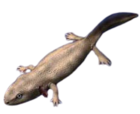Karauridae
| Karauridae Temporal range: Jurassic-Cretaceous
| |
|---|---|

| |
| Karaurus sharovi | |
| Scientific classification | |
| Domain: | Eukaryota |
| Kingdom: | Animalia |
| Phylum: | Chordata |
| Class: | Amphibia |
| Clade: | Caudata |
| Family: | †Karauridae Ivachnenko, 1978 |
| Genera | |
The Karauridae are a family of stem-group salamanders (Caudata) that are known from the Middle Jurassic to Early Cretaceous in Central Asia (Kazakhstan and Kyrgyzstan), Northern Asia (Siberia, Russia) and Western Europe (United Kingdom). The family includes four members: Karaurus from the Middle-Late Jurassic Karabastau Formation of Kazakhstan, Kokartus from the Middle Jurassic Balabansai Formation of Kyrgyzstan, Marmorerpeton from the Middle Jurassic Forest Marble Formation of England and Kilmaluag Formation of Scotland, and Kuzbassia from the Early Cretaceous (Aptian) Ilek Formation (Kemerovo Oblast, Russia).[1][2] The members are some of the oldest known salamanders.[3][4] The family is united by several morphological characters, including sculptured skull roof bones.[1] Like some modern salamanders, karaurids were neotenic.[1] Members of the family likely fed via suction feeding on small fish and invertebrates.[5] The Early Cretaceous Siberian Kulgeriherpeton has been suggested to be a karaurid by some authors.[6]
References[edit]
- ^ a b c Jones, Marc E. H.; Benson, Roger B. J.; Skutschas, Pavel; Hill, Lucy; Panciroli, Elsa; Schmitt, Armin D.; Walsh, Stig A.; Evans, Susan E. (2022-07-11). "Middle Jurassic fossils document an early stage in salamander evolution". Proceedings of the National Academy of Sciences. 119 (30): e2114100119. Bibcode:2022PNAS..11914100J. doi:10.1073/pnas.2114100119. ISSN 0027-8424. PMC 9335269. PMID 35858401.
- ^ Skutschas, P.; Kolchanov, V.; Anpilogova, E.; Parakhin, I.; Averianov, A.; Jones, M. (2023). "The last of them? A new relic karaurid stem salamander from the Lower Cretaceous of Western Siberia, Russia". Biological Communications. 68 (4): 219–226. doi:10.21638/spbu03.2023.402.
- ^ Averianov, Alexander O.; Martin, Thomas; Skutschas, P. P.; Rezvyi, A. S. & Bakirov, A. A. (2008). "Amphibians from the Middle Jurassic Balabansai Svita in the Fergana Depression, Kyrgyzstan (Central Asia)" (PDF). Palaeontology. 51 (2): 471–485. doi:10.1111/j.1475-4983.2007.00748.x.
- ^ Marjanović, D. & Laurin, M. (2014). "An updated paleontological timetree of lissamphibians, with comments on the anatomy of Jurassic crown-group salamanders (Urodela)". Historical Biology. 26 (4): 535–550. doi:10.1080/08912963.2013.797972. S2CID 84581331.
- ^ Skutschas, Pavel; Martin, Thomas (April 2011). "Cranial anatomy of the stem salamander Kokartus honorarius (Amphibia: Caudata) from the Middle Jurassic of Kyrgyzstan: Skull of Jurassic Stem Salamander". Zoological Journal of the Linnean Society. 161 (4): 816–838. doi:10.1111/j.1096-3642.2010.00663.x.
- ^ Skutschas, Pavel P.; Kolchanov, Veniamin V.; Averianov, Alexander O.; Schellhorn, Rico; Kolosov, Petr N.; Jones, Marc E.H.; Martin, Thomas (December 2023). "The northernmost occurrence of non-karaurid salamanders (Lissamphibia, Caudata) in the Mesozoic". Cretaceous Research. 152: 105686. doi:10.1016/j.cretres.2023.105686.
External links[edit]




